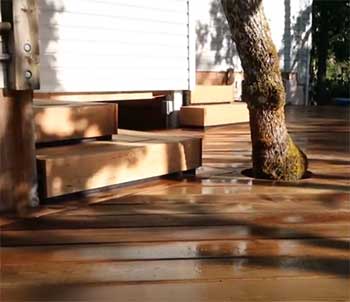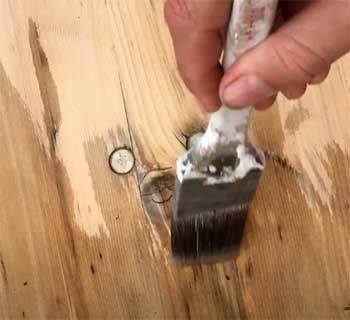If you know wood, you know preserving them for a long time takes some extra effort. This is why people use things like wood stain, treatment, and sealant on their wood.
Lifetime wood treatment is one of the familiar names when it comes to wood treatments, surprisingly for both good and bad reasons.
Valhalco’s Lifetime wood treatment has made a pretty big fuss for some not-so-positive reasons. The user complaints are interesting, to say the least.
Here are some of the problems the users have faced with this wood treatment.
Problems With The LifeTime Wood Treatment

First things first, wood treatments (or sealants) and their result depend on a lot of factors. And the results also vary depending on them.
So it is natural that there will be some discrepancies among the results different users get.
The problem with the Lifetime treatment is, the narratives and results from different people are vastly different. Some would like to compare it with a magical solution, the others can’t possibly disagree more.
Wood treatments are a serious business and you can’t just change them once it is done. So it is better to know what problems you might end up facing if you choose one.
Here are some of the most common complaints users noted with Valhalco’s Lifetime wood treatment.
- Confusing Description On The Website
What do you do before you buy something online?
Definitely check the product description to see if you’re missing something. With Lifetime, however, they seem to be missing something- a solid description of their product.
The Lifetime wood treatment is marketed as a treatment to protect the wood. But on their website, they refer to this product as a stain.
Most descriptions are about how this is a whole new addition to the world of stains or how it is priced below the average wood stains.
On top of that, the website never seems to recommend ground contact for this product. This adds to the confusion more, is it a wood treatment or is it a stain?
Most users use it like a treatment, but the output gap might be better explained if the Lifetime treatment is considered a stain.
- Unpredictable Color and Gray Stain
You might think about letting this one slide. Stains vary on woods depending on lots of factors all the time, right?
So this should be chalked up as normal. But unfortunately, that’s not the case because this wood treatment’s stain varies way too much on wood.
When you decide to go with Lifetime wood treatment, your woodworker guy will definitely tell you about the color issue.

The color is very unpredictable and you never know what kind of stain you’re going to get.
It is uncertain enough and becomes worse when you factor in your wood, primer, base, and age.
That is just one problem and it is surprisingly the smaller one.
Lifetime wood treatment is notorious for giving the woods a greenish-gray stain.
No matter what wood you’re using, you’ll get this swamp-colored stain that is supposed to make your wood look more aged.
That reason makes sense but only before you see the results. The green-gray is strong enough to overpower any other color around it.
If you’re using this treatment inside your rooms, you’ll only have the ranges of blue and green to go with it. It will contrast everything else and not in a nice way.
Unless you’re specifically looking for this greenish tint, it will be hard planning everything around an unpredictable stain. This is one of the most common complaints this wood treatment gets.
- Strange Natural Ingredient In The Mix
What would you expect in the ingredient list of a wood treatment?
Chemicals, of course. But not with this treatment it seems. The Valhalco Lifetime wood treatment uses some irrelevant natural ingredients with chemicals and it is hard to pinpoint what they do.
If you check the label of the wood treatment you’ll find odd ingredients like dried mushroom, dried basil, tea, oregano, etc. in it. And that’s actually what they put in the treatment which somehow makes it worse.
Most of these ingredients have nothing to do with stains or the protection of the wood. Some users claim that these have something to do with killing the sugar in wood.
The absence of sugar then protects the wood from rot and mold. But even they can’t pinpoint the elements that are supposed to do the killing.
Some users believe the old dried mushrooms, basil, dried flowers, and tea have something to do with the opposite and rot the wood faster.
There has been no solid proof against this either. So right now these ingredients just stand in the middle and no one knows what they really do.
Is the LifeTime Wood Treatment Worth It?

You know the risks now, but how about the overall picture?
Is this wood treatment worth it?
That will depend on your personal preference.
The results seem to vary a lot among users so there is always a risk. You may not end up with the outcome you want.
If you’re okay with that uncertainty, then the Lifetime wood treatment is worth it.
On the plus side, a lot of users believe their wood would’ve splintered or be in a worse condition if they didn’t use the treatment.
So if your woodworker guy (or maybe your fellow woodworkers) agrees, Lifetime wood treatment might just be worth a shot.
Frequently Asked Questions (FAQ)
Here are a bunch of questions people usually ask about Lifetime wood treatment.
According to the website, yes. Valhalco claims this treatment protects wood against rot, mold, and splints.
Yes, you can stain over the treatment or even apply a sealant. But Valhalco advises against staining over the treatment so it is better not to do that.
Wood preserver protects the wood from external factors like insect attacks and fungus problems. Wood treatment on the other hand protects wood from internal issues like UV ray damage.
Yes, you can. But it is better to go for tints or buy tinted wood treatments for the best results.
Conclusion
Wood treatments are a very serious business considering you can’t take them off easily. This is why it is better to go through complaints against LifeTime wood treatment before you get some for yourself.
Make sure to ask your woodworking guy about them before making a decision so you’ll have a better perspective.

Unless you’re specifically looking for this greenish tint, it will be hard planning everything around an unpredictable stain. This is one of the most common complaints this wood treatment gets. …Lol. is it? Cos this is the first time I’ve ever seen it. Its not difficult to plan anything around neutral tones.
And what do you expect to find in preserve or tint – chemicals you say….. Except when people are looking for a non-chemical version of course…. Then you’d be pretty upset if you did find these things.
Also the fact that they don’t know why it works definitely doesn’t mean it doesn’t work. I have MS, doctors don’t know why my body attacks itself but it does. They also don’t really know how some of my medications work, only that they do. Thankfully they didn’t wait for the how.
I’m personally far more disappointed by all the chemical treatments I used in the garden than I am with the natural looking grey tint on the wood I used lifetime on. The rest looks like trash at 3 years no matter what it promised. And will be a much more harduous and costly task to make nice.
None of my wood will last forever and I don’t want it too. The earth needs to be able to take resources back once we are all long gone… Including us.
I’m asking the same questions – does this stuff work? and what is it? The partial list of ingredients above is the most specific info I’ve seen so far. One comment to add here, is that there are some essential oils that have been tested and proven to have anti-microbial properties. Among those, Oregano essential oil is one of the strongest. Could be the approach they Valhalla is taking.